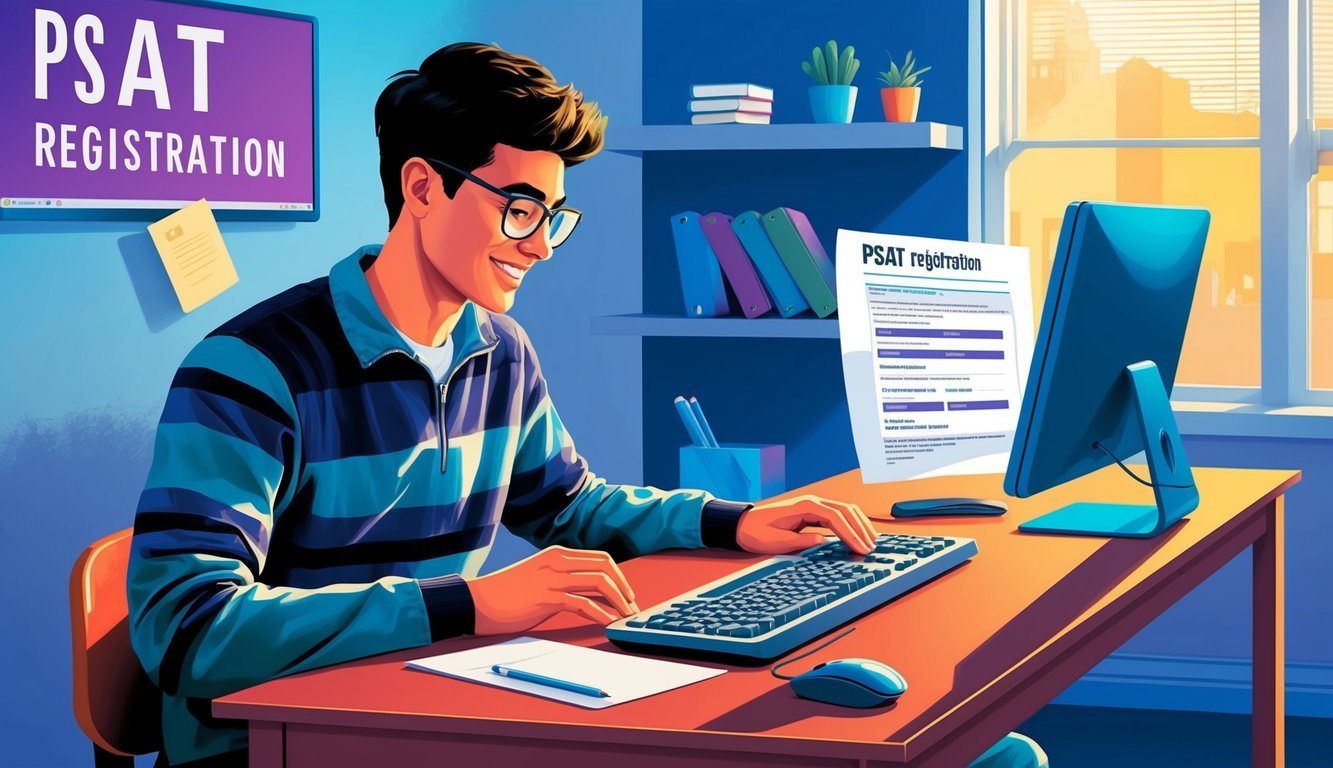“`xml
Taking the PSAT/NMSQT is an important step for high school students—and it doesn’t have to be daunting! This test is a fantastic opportunity to gear up for the SAT and even get a shot at some scholarships.
Students usually sign up for the PSAT/NMSQT via their high school, and the timing is typically in September or early October.
Just a note: it’s all in the timing, so keep your eyes peeled!

While the PSAT is mainly for 11th graders, 10th graders might join in the fun too.
Remember, it’s more than just scores—it’s a sneak peek at the SAT experience.
Plus, it can help you access college and career planning tools that can make a real difference.
If you’re wondering how to dive in, have a chat with your school counselor.
They’ll have all the info you need about when and how to sign up.
The test dates usually land in October, and some schools set deadlines for signing up, so asking early is a smart play.
Counselors can also help with questions about fees, test locations, and any accommodations you might need.
Don’t forget to inquire about signing up for AP tests in the spring, too.
Trust me, planning ahead can keep your stress levels down as deadlines approach!
Key Takeaways
- To sign up for the PSAT/NMSQT, go through your high school, not the College Board.
- This test is primarily for 11th graders and takes place in October.
- Your school counselor is your first stop for all things registration-related.
Getting to Know the Basics
The PSAT/NMSQT is a standardized test that gets you ready for college and can open doors to scholarships.
It’s one of several tests designed to assess academic skills.
What’s the PSAT/NMSQT?
So, what exactly is the PSAT/NMSQT? It stands for Preliminary SAT/National Merit Scholarship Qualifying Test.
Think of it as a practice run for the SAT, typically taken during junior year.
The test has two main sections: Reading and Writing, and Math.
Each one dives into skills you’ll need for college.
You’ll have about 2 hours and 14 minutes to complete the test.
Most of it is multiple choice, but you’ll face some written answers in math too, just to keep you on your toes!
Taking the PSAT/NMSQT is a great way to get ready for the SAT.
It’s like having a practice game before the big match, helping you figure out where you stand and what to sharpen up.
The National Merit Scholarships Connection
But wait, the PSAT/NMSQT is more than just practice! It’s also your ticket into the National Merit Scholarship Program.
This program awards scholarships to top scorers.
The National Merit Scholarship Corporation uses a special score called the Selection Index to find semifinalists.
It’s pretty simple: they double your Reading and Writing score and add it to your Math score.
The best possible Selection Index score? A whopping 228.
Those who score high might earn the title of National Merit Scholar, which can be a game-changer for college admissions and snagging that scholarship money.
Differences Between PSAT/NMSQT, PSAT 10, and PSAT 8/9
The College Board offers a trio of PSAT tests to fit different grade levels.
The PSAT/NMSQT is your go-to for 11th graders (and the occasional 10th grader) and it’s the only one that counts for National Merit Scholarships.
If you’re in 10th grade, you’d want to check out the PSAT 10.
It’s similar to the PSAT/NMSQT but doesn’t qualify you for National Merit Scholarships.
The PSAT 8/9 is geared toward 8th and 9th graders.
It’s the easiest of the bunch and helps younger students kick off their college prep journey.
All these tests are designed to help you track your progress and prepare for the SAT—like a GPS for your academic journey.
Signing Up Made Simple
Signing up for the PSAT is pretty straightforward if you know the basics.
Let’s run through important info like dates, costs, and what to expect on test day to help you sail through registration.
Starting the Registration Process
Your journey starts at school! You’ll sign up for the PSAT at school, not directly with the College Board.
The first step? Chat with your school counselor.
They’ll lay out the exact registration process for your school.
If you’re homeschooled, it’s a different ball game.
You’ll need to find a local high school that welcomes outside students to test.
The College Board’s high school search tool can help you track down a nearby site offering the PSAT.
Oh, and if you don’t have a College Board account yet, now’s the time to create one.
You’ll need it to access your PSAT/NMSQT scores later on.
Key Dates and Deadlines
The PSAT/NMSQT generally happens in October.
Schools choose from several test dates during a specific window.
Usually, those dates are between October 1-31, so mark your calendars!
There are often two Saturday options halfway and later in October.
Make sure to check with your school for which date they’ve picked, though.
As for registration deadlines, those are usually set by each school and can be a few weeks before test day.
It’s always a good idea to ask your school counselor about these deadlines early to avoid any last-minute scrambles.
Understanding Costs and Fee Waivers
Now, let’s talk money.
The PSAT/NMSQT has a fee, but that cost can shift from year to year.
A lot of schools pick up some or all of the tab for their students.
If money’s tight, don’t sweat it! Fee waivers are available to eligible students who need help covering the fee.
You’ll handle these through your school, not directly with College Board.
Thinking of requesting a fee waiver? Here’s how:
- Have a chat with your school counselor.
- Provide any necessary documentation showing financial need.
- Get your request in well before the registration deadline.
Sometimes, nonprofit colleges may also offer extra support or resources for students using fee waivers.
What to Expect on Test Day
When test day rolls around, make sure to arrive at your school or designated test location early.
Don’t forget to bring:
- A valid photo ID
- Two No. 2 pencils
- An approved calculator
You’re looking at about 3 hours for the whole test, which includes sections on Reading, Writing and Language, and Math.
Here’s what you can expect:
- Short breaks between sections
- Strict time limits on each part
- Clear instructions from test proctors
Frequently Asked Questions

Signing up for the PSAT might seem a bit tricky, but it’s all manageable once you know what to do.
Let’s tackle some common questions about PSAT registration—keep it simple!
What’s the easiest way to register for the PSAT online?
Most students can’t sign up online by themselves.
Schools take care of that.
Just ask your school counselor; they’re your go-to person for forms and info.
What’s the latest I can sign up for the PSAT in 2024?
The PSAT/NMSQT usually happens in October.
Exact deadlines depend on your school, typically a few weeks before the test date.
Make sure to check with your school for the final cutoff!
Any tips for signing up my homeschooled student for the PSAT?
Homeschooled students can definitely take the PSAT too! Find a local high school that allows outside students to test.
Give them a call early on to ask about their registration process and deadlines.
If I’m not enrolled in a school, how can I take the PSAT?
Even if you’re not enrolled in a traditional school, you can still take the PSAT! Just reach out to nearby high schools to see if they accept external testers.
You may need to pay a fee and follow their specific sign-up rules.
What’s the cost to participate in the PSAT?
The PSAT has a fee that varies every year.
Schools often cover costs for their students, but if not, expect to pay around $18.
If these costs are an issue, remember, fee waivers might be an option if you qualify!
How do I figure out the closest place to take the PSAT?
You can find test locations by using the College Board’s school search tool.
Just input your zip code and you’ll uncover nearby schools offering the test.
Then, give them a call to see if they let outside students take it.
“`

